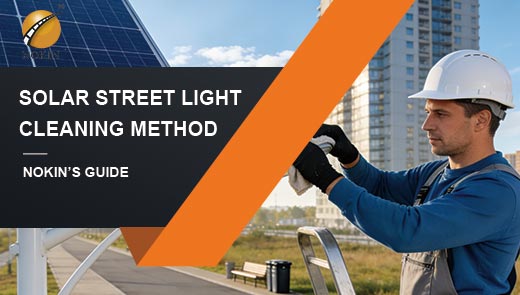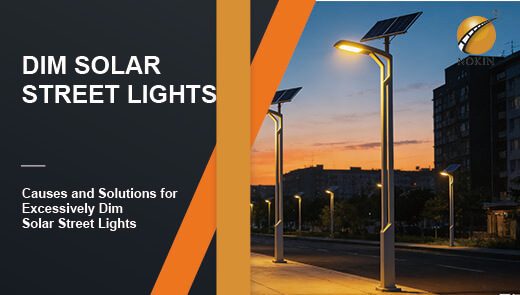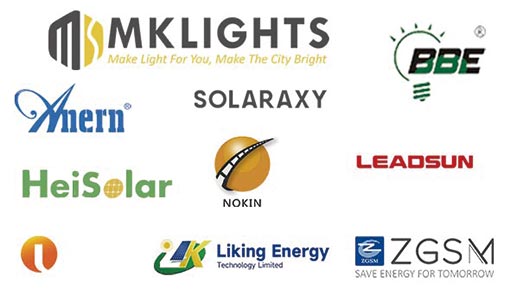How Tall Are Solar Street Lights
Under the wave of the era of energy transition and green development, solar street lights have gradually become the mainstream lighting choice for urban roads, rural trails, business parks and other scenarios by virtue of their environmentally friendly and energy-saving, convenient installation and other advantages. However, many users in the procurement and installation process, often overlooked a key element -- street light height. The seemingly simple height setting is the core parameter that affects the lighting effect, energy utilization efficiency and usage experience. Appropriate installation height not only ensures uniform light coverage of the target area, but also improves the charging efficiency of solar panels, while avoiding light pollution and energy waste. In this article, Nokin will analyzes the issues related to solar street light height from multiple dimensions, and provide you with professional and practical installation guidance.
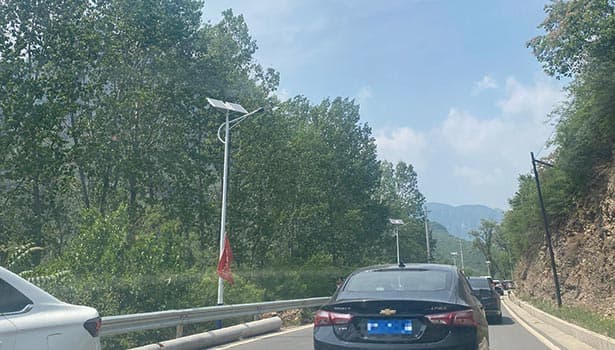
Why Is the Height of Solar Street Lights Important?
Lighting coverage area
The core function of solar street light is to provide sufficient lighting for a specific area, and the installation height directly determines the coverage of light. From the point of view of optical principle, the higher the light pole, the larger the radius of light projection, but the light intensity per unit area will be weakened; on the contrary, too low a mounting height will lead to too much concentration of light, forming a “spot effect”, resulting in part of the area is too bright and the surrounding dim. For example, installing a 3-meter-high street light on a rural path may only illuminate the footpath, while the green belt on both sides is in shadow; while installing a 12-meter-high solar street light on a city trunk road may cover the entire lane, but the road illumination may be insufficient, affecting driving safety.
In order to achieve the best lighting effect, it is necessary to find a balance between the coverage area and light intensity. This requires the installer to accurately calculate the height of the pole according to the needs of the actual scene, to avoid wasting resources and to ensure the quality of lighting.
Light distribution and intensity
Different scenes have different requirements for lighting intensity and distribution. In highways and other major traffic routes, large, uniform lighting is needed to ensure the safety of vehicles, when 10-12 meters of high solar street lights can effectively reduce the blind spot; while in the residential garden path, 3-4 meters of low street lights are more suitable for creating a warm, soft atmosphere, while avoiding light interference with the residents' lives.
In addition, the height also affects the angle of light projection. The light of high solar street lamps is more likely to spread to the distance, which is suitable for open areas; the light of low street lamps is more concentrated in the near area, which is suitable for local illumination. Therefore, a reasonable choice of height can not only optimize the lighting effect, but also reduce light pollution and achieve the goal of green lighting.
Standard Heights of Street Lights
Low Height Street Light (10 - 15 feet / about 3 - 4.6 meters)
Low-height solar streetlights are commonly used in residential areas, villa courtyards, park trails and other scenarios. The advantages are:
Reduced glare
The lower installation height brings the light closer to the ground, effectively avoiding the discomfort caused by direct sunlight;
Precise lighting
Suitable for localized lighting in small areas, such as sidewalks, green belts, etc;
Atmosphere creation
Soft light can add a sense of warmth to the living environment, while reducing light interference with the surrounding residents.
Medium Height Street Lights (15 - 25 feet / approx. 4.6 - 7.6 meters)
Medium-height streetlights are widely used in suburban roads, commercial streets, and medium-sized parking lots. Features of these streetlights include:
Wide coverage
Able to meet the lighting needs of medium-sized areas and effectively improve road safety;
Light pollution control
Through the reasonable height setting, not only to ensure adequate lighting, but also to reduce the light scattering to the high altitude;
Suitable for a variety of scenarios
Whether it is a street with many pedestrians or a parking lot with vehicles, it can provide stable and reliable lighting.
High Height Street Light (25 - 30 feet / approx. 7.6 - 9.1 meters)
High-height solar streetlights are mainly used for highways, airport runways, mega parking lots and other places that require very high illumination. Its significant advantages are reflected in:
Large area coverage
A single solar street light can illuminate an area of hundreds of square meters, reducing the number of light poles and lowering installation costs;
Long-distance lighting
Suitable for faster traffic scenes, ensuring that drivers can clearly identify road conditions at a distance;
Adaptability to harsh environments
The higher installation height makes the solar led street light less susceptible to natural disasters such as snow and flooding, guaranteeing continuous lighting.
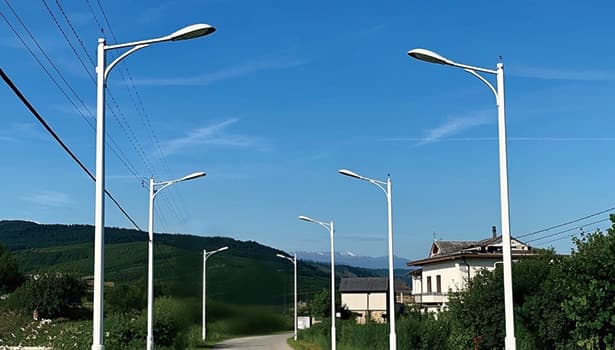
Relationship Between Road Width and Solar Street Light Height and Power
Narrow Road (5 - 8 meters)
For narrow roads with a width of 5-8 meters, such as countryside lanes and internal roads of small communities, it is recommended to adopt a pole height of 5-7 meters and match it with a low-power street light of 30-60 watts. The advantages of this combination are:
Precise coverage
The lower pole height allows the light to be focused on the road surface, avoiding wastage;
Energy saving
Small lighting needs can be met by low power luminaires, reducing energy consumption;
Flexible installation
The low pole height makes it easier to construct and maintain, especially for areas with limited space.
Medium Width Streets (8 - 12 meters)
For streets 8-12 meters wide, such as township main roads and city secondary roads, it is recommended to use a pole height of 8-10 meters with a 60-100 watt street light. This configuration is rationalized by:
Adequate illumination
The higher pole height ensures that the light covers the whole road surface and reduces the dead space of illumination;
Uniform distribution
By adjusting the angle of the lamps, the light can be evenly projected on the road surface;
Adaptation to traffic demand
Meet the vehicle traffic, but also to protect the safety of pedestrians, taking into account a variety of use scenarios.
Wide Road (more than 12 meters)
For the width of more than 12 meters wide road, such as city trunk roads, highways, need to use more than 10 meters of high street lamps, and with more than 100 watts of high-power lamps and lanterns. The necessity is reflected in:
Wide-area coverage
High-pole design enables the light coverage to be greatly improved to meet the demand for simultaneous illumination of multiple lanes;
High-intensity lighting
High-power lamps provide sufficient light intensity to ensure nighttime driving safety;
Reducing blind zones
Through reasonable pole spacing and height settings, road lighting blind zones can be effectively eliminated.
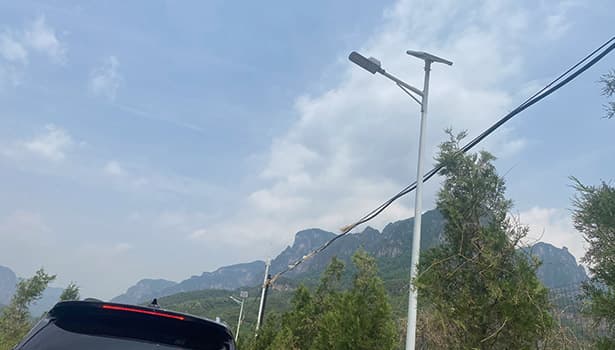
Key Considerations When Choosing the Installation Height
Type of Area to Be Illuminated
Different scenes have significant differences in lighting needs:
Highways and main roads: 10-12 meters of high-pole streetlights are recommended to ensure even lighting over long distances and large areas;
Small roads and parking lots: 6-8 meters of low to medium height streetlights are sufficient to meet local lighting needs;
Residential gardens and paths: 3-4 meters of low-post streetlights provide both comfortable lighting and a cozy atmosphere.
Brightness and Beam Angle of Solar Street Lights
The brightness and beam angle of the solar powered street light directly influence the choice of installation height:
Wide beam angle: Suitable for 10-12 meters high pole installation, can evenly spread the light to a large area;
Narrow beam angle: More suitable for 6-8 meters of low pole installation, can realize the concentration of light projection, to avoid waste.
Environmental factors
The natural environment is also a consideration that cannot be ignored:
Windy areas: High-pole solar street lights need to be equipped with stronger bases and windproof structures, or appropriately reduce the height to enhance stability;
Snowy areas: It is recommended to install high poles of more than 8 meters to avoid snow blocking the solar panels and affecting the charging efficiency;
Coastal areas: In addition to considering the height, it is also necessary to choose anti-corrosion materials to extend the service life of the solar street light.
How to Install Solar Street Lights at the Right Height
Choose the Right Height of Light Pole
Before installation, it is necessary to comprehensively consider the type of area, road width, lighting needs, environmental conditions and other factors, if necessary, with the help of professional lighting design software to simulate calculations, to ensure that the selection of the most optimal height of the light pole.
Install the Street Light at the Best Angle
The installation angle of solar powered led street lights directly affects the lighting range and uniformity:
Horizontal angle: Adjust the direction of the lamps according to the direction of the road to ensure that the light covers the target area;
Vertical angle: Realize the light projection near and far by fine-tuning, avoiding over-bright or over-dark areas.
Ensure that Solar Panels are Fully Exposed to Light
The installation position and angle of solar panels are directly related to charging efficiency:
Orientation: Prioritize south-facing installation to ensure sufficient light throughout the day;
Tilt adjustment: Adjust the tilt angle of the solar panels according to the local latitude to maximize light energy absorption;
Obstacle avoidance design: Keep away from trees, buildings and other obstructions to avoid shadows affecting the charging effect.
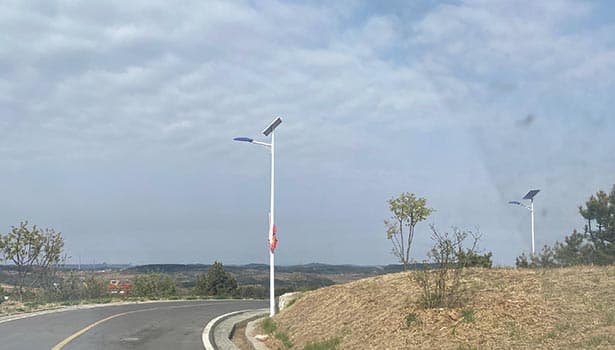
Conclusion
The installation height of solar street lights is a complex issue involving multiple disciplines such as optics, engineering, and environmental science. From lighting coverage, light distribution to scene adaptation, environmental factors, each link needs to be carefully considered. Only through scientific and reasonable height selection and installation, can we give full play to the performance advantages of solar street lights and realize the perfect balance of efficient lighting, energy saving and environmental protection and user experience. In the future construction of cities and villages, Nokin hopes that the content of this article can provide you with practical references to help create a greener and smarter lighting environment.

